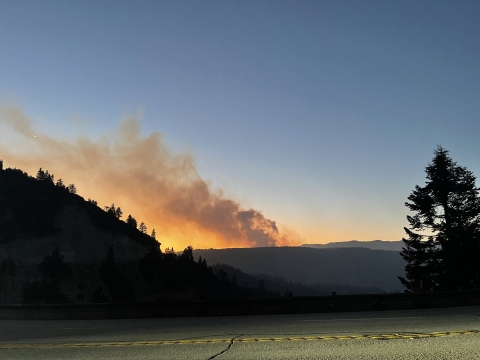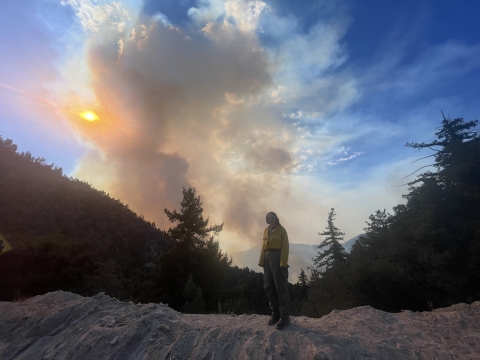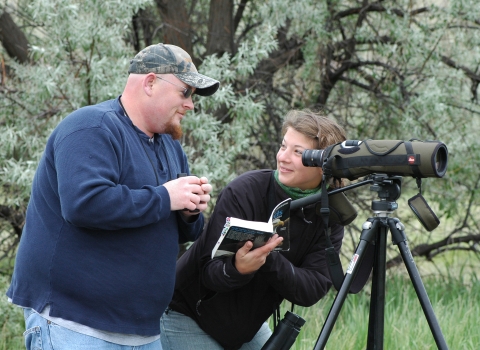Each year, as temperatures rise and prolonged droughts take hold, wildfires sweep through the country, with a seemingly increased ferocity each season. With significant wildfire activity, the U.S. reached Preparedness Level 5 — the highest level on the scale — in July this year.
Many U.S. Fish and Wildlife Service employees are no strangers to fire. Staff are trained to use prescribed fire to improve wildlife habitat and decrease wildfire risk. For some, it’s a full-time job; for others, it’s a collateral duty. But when the call goes out for help with dangerous wildfires, staff of all stripes answer, leaving behind their normal duties and families, at a moment’s notice, to deploy to campsites and pop-up communities for weeks on end.
“The 2024 fire year was beyond busy for firefighters in the Service’s wildland fire program, as well as collateral-duty fire responders,” explained Art Canterbury, the Northeast Region’s fire management coordinator. “From January through May, staff were conducting prescribed fire to decrease the excess vegetation that often fuels uncontrolled wildfires. During the same time, staff were responding to wildfires in the local areas, supporting both local and state fire responses.”
No longer does ‘fire season’ describe the summer months out west; today, our wildland firefighters are prepared to respond year-round. This year in the Northeast, the Service has filled more than 80 resource orders to support wildfire suppression throughout the country. October 17, 2024, marked the latest in the year our country has ever been at Preparedness Level 5, which lasted a staggering 58 days.
A burning passion
Tomas Liogys, fire management specialist based out of Great Swamp National Wildlife Refuge in New Jersey, helps manage 120,000 acres with prescribed fire throughout New Jersey, New York and Pennsylvania.
In addition to his prescribed fire work, he also deploys to wildfires every year, where he specializes in fire planning, intelligence and tracking resources. This summer, his work days in Washington and Oregon often stretched to 15 hours or more.
Uncontrolled wildfires hit closer to home for Liogys, too. The 192-acre Industrial Parkway fire burned just 10 miles from the Service fire program office and six miles from Great Swamp National Wildlife Refuge.
Liogys has been deployed on assignments every fire season for 30 years and sacrifices a lot to bring his expertise to the front lines. He emphasized how his fire assignments take a toll on his family.
"The western fire season can span from April to October, so I’ve missed birthdays, anniversaries, and more first days of school than I’ve attended,” Liogys explained. “ln 2016, I even missed my opportunity to vote in the presidential election.” But his dedication to wildland fire never wavered.
When not organizing efforts on the ground, Liogys educates others on the importance of prescribed fire as a management tool and that not all fire is bad.
Kindling connection
Administrative staff, scientists, budget professionals, communicators, law enforcement officers and more have a place in the fire community. All skills and job types are needed to organize a response of this magnitude.
Information Technology professionals Joe Pinnetti and Max Riley also answered the call to support the western fire season, leaving their homes in Massachusetts for tent camping in California. Together, they spent two weeks supporting the IT needs of the Hill Fire basecamp, including managing internet connections, setting up WIFI, fixing computers and printers, and keeping lines of communication open and in operation. Both are grateful for the chance to put their technical skills to good use during an emergency.
“A wide array of skillsets are needed to make the fire response happen,” Pinnetti said. “It’s also an opportunity to meet new people and learn new processes. You find new ways to use your skills to help.”
Riley is inspired by the wildfire response efforts and sees his support as an extension of the Service mission — protecting our federal lands and natural resources in addition to supporting our colleagues and the American public.
“In addition to supporting the emergency response, working together across the Department of the Interior and with state and local agencies is a great way to share ideas and solutions, build connections, and bring new skills home to the Service,” he explained.
The comradery and skill-sharing of the fire teams extends well past fire season. Riley is still in touch with Bureau of Land Management friends from his first fire four years ago. This year, he connected with a member of the budget team for the Service; they plan to collaborate on a project as part of their normal duties.
Igniting a calling
Summer Muscher-Malone, invasive species invasive species
An invasive species is any plant or animal that has spread or been introduced into a new area where they are, or could, cause harm to the environment, economy, or human, animal, or plant health. Their unwelcome presence can destroy ecosystems and cost millions of dollars.
Learn more about invasive species biological technician at Wallkill River National Wildlife Refuge in New Jersey, had no idea what to expect in her first deployment as a resource advisor in Southern California; but she was eager to find out.
Working alongside staff from multiple agencies, Muscher-Malone helped repair and restore habitat damaged by fire lines and heavy equipment used to prevent blazes from spreading. She never expected to work directly with heavy equipment operators but found the experience built her confidence. She enjoyed doing her part to support the country in times of need.
Despite the stress and concern about being away from her father, elderly grandmother and beloved pup, she decided to extend her fire detail a week. She encourages everyone to try it least once.
“My fire team became my family,” she said. “I met people from all over the country, and it was an incredibly supportive group, especially my mentor Cass Williamson.”
Comradery is a common theme among the fire community, and many express it as one of the main reasons they’ll return to serve again. There’s nothing quite like the rugged lifestyle, sacrifices and meaningful, real-world outcomes that bring the community together.
Despite the unique roles and responsibilities of Service personnel responding to wildfires across the country, one thing remains constant. Fire assignments are a calling and a huge commitment to serving our country and our mission. The Service is grateful for all the responders who did their part to battle blazes this season.
Liogys says it best. “Even on the worst fire, everyone says yes to going back.”’








